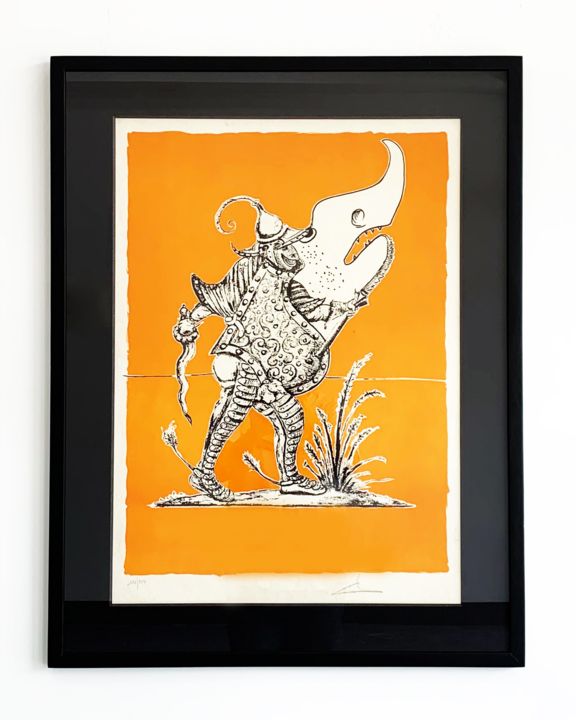





Set of four Lithographs by Salvador Dalí (1973) Printmaking by Salvador Dali
Not For Sale
Seller DAKKARA Art Galleries
-
Limited Edition (#1/250)
Printmaking,
Lithography
on Paper
- Number of copies available 1
- Dimensions Height 29.9in, Width 21.3in
- Framing This artwork is not framed
- Categories Printmaking from $20,000 Surrealism
Size Europe: 76 × 54 cm (without frame) | 102 x 70 x 3 cm (with frame)
Edition: 111/250
4 lithographs from the famous series “Les Songes Drolatiques de Pantagruel” (Pantagruel's Comical Dreams) by Salvador Dali, 1973, lithograph of gouaches and felt pencil on Japanese paper.
The collection created by Salvador Dalí (1904-1989) consists of a series of phantasmagorical representations for the novels written in the 1530s by François Rabelais, narrating the adventures of two giants - Gargantua and his son Pantagruel - “The Horrible and Terrifying Deeds and Words of the Very Renowned Pantagruel King of the Dipsodes, Son of the Great Giant Gargantua”. This book of tall tales, commonly known as Pantagruel, is chronologically the second volume of a series that follows the outlandish escapades of a family of giants.
The Surrealists examination of the human psyche and dreams reached new apices in the works of Salvador Dalí. In his “Songes” Dalí explored a deeply erotic dimension, studying the writings of Richard von Krafft-Ebing (1840-1902) and Sigmund Freud, and conceiving what he called the “paranoiac-critical method” to abet his creative process.
This sort of illustration on one-dimensional fields of color offers a sense of animation common to storytelling comics. “Les Songes” prove that Dalí was fearless and unapologetic. Even in the most vile, obscene subject matter—Dalí manages to find the sophistication in its humor. When it comes to Dalí, nothing is out of bounds.
Related themes
Salvador Dalí, born on May 11, 1904, in Figueres, Catalonia, Spain, was one of the most renowned surrealist artists of the 20th century. His extraordinary talent, eccentric personality, and flamboyant style made him a legendary figure in the art world.
Dalí showed artistic promise from a young age and began formal art training at the Royal Academy of Fine Arts of San Fernando in Madrid. During his time in Madrid, he experimented with various styles, including impressionism and cubism, before discovering surrealism, a movement that would profoundly shape his artistic vision.
In the early 1920s, Dalí moved to Paris, where he became immersed in the surrealist movement led by André Breton. His iconic paintings from this period, such as "The Persistence of Memory" (1931), featuring melting clocks draped over surreal landscapes, established him as a leading figure in the surrealist movement.
Dalí's artistic genius was not confined to painting; he also dabbled in sculpture, film, photography, and writing. His collaborations with filmmakers such as Luis Buñuel resulted in groundbreaking works like the surrealist film "Un Chien Andalou" (1929).
Throughout his career, Dalí cultivated a larger-than-life persona characterized by his flamboyant attire, trademark mustache, and eccentric behavior. He thrived on controversy and self-promotion, often engaging in provocative stunts to garner attention.
Despite his eccentricities, Dalí's artistic brilliance was undeniable, earning him international acclaim and admiration. His works were exhibited in prestigious galleries and museums around the world, cementing his status as one of the most influential artists of the 20th century.
Dalí passed away on January 23, 1989, leaving behind a rich and diverse body of work that continues to captivate and inspire audiences to this day. His contributions to surrealism and the broader art world ensure that his legacy as a visionary artist will endure for generations to come.
-
Nationality:
SPAIN

- Date of birth : 1904
- Artistic domains: Represented by a Gallery,
- Groups: Contemporary Spanish Artists Artists presented by a gallery










 Adrian Cheng: the visionary behind K11
Adrian Cheng: the visionary behind K11
 Salvador Dalí: Provocateur of Surrealism and Cultural Icon
Salvador Dalí: Provocateur of Surrealism and Cultural Icon

![Niemoc [Czyściec: pieśń 3]](https://medias.artmajeur.com/home/17986561_c3.jpg?v=1738218831)

